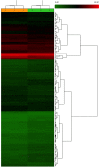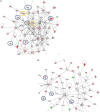Lifelong Football Training: Effects on Autophagy and Healthy Longevity Promotion
- PMID: 30837897
- PMCID: PMC6390296
- DOI: 10.3389/fphys.2019.00132
Lifelong Football Training: Effects on Autophagy and Healthy Longevity Promotion
Abstract
Aging is a physiological process characterized by a progressive decline of biological functions and an increase in destructive processes in cells and organs. Physical activity and exercise positively affects the expression of skeletal muscle markers involved in longevity pathways. Recently, a new mechanism, autophagy, was introduced to the adaptations induced by acute and chronic exercise as responsible of positive metabolic modification and health-longevity promotion. However, the molecular mechanisms regulating autophagy in response to physical activity and exercise are sparsely described. We investigated the long-term adaptations resulting from lifelong recreational football training on the expression of skeletal muscle markers involved in autophagy signaling. We demonstrated that lifelong football training increased the expression of messengers: RAD23A, HSPB6, RAB1B, TRAP1, SIRT2, and HSBPB1, involved in the auto-lysosomal and proteasome-mediated protein degradation machinery; of RPL1, RPL4, RPL36, MRLP37, involved in cellular growth and differentiation processes; of the Bcl-2, HSP70, HSP90, PSMD13, and of the ATG5-ATG12 protein complex, involved in proteasome promotion and autophagy processes in muscle samples from lifelong trained subjects compared to age-matched untrained controls. In conclusion, our results indicated that lifelong football training positively influence exercise-induced autophagy processes and protein quality control in skeletal muscle, thus promoting healthy aging.
Keywords: autophagy; cardiovascular capacity; football; lifelong training; longevity.
Figures




Similar articles
-
Insight into the Molecular Signature of Skeletal Muscle Characterizing Lifelong Football Players.Int J Environ Res Public Health. 2022 Nov 28;19(23):15835. doi: 10.3390/ijerph192315835. Int J Environ Res Public Health. 2022. PMID: 36497910 Free PMC article.
-
Effect of lifelong football training on the expression of muscle molecular markers involved in healthy longevity.Eur J Appl Physiol. 2017 Apr;117(4):721-730. doi: 10.1007/s00421-017-3562-8. Epub 2017 Mar 1. Eur J Appl Physiol. 2017. PMID: 28251397
-
Regulation of apoptosis and autophagy in mouse and human skeletal muscle with aging and lifelong exercise training.Exp Gerontol. 2018 Oct 1;111:141-153. doi: 10.1016/j.exger.2018.07.011. Epub 2018 Jul 17. Exp Gerontol. 2018. PMID: 30030137
-
Long-Term Recreational Football Training and Health in Aging.Int J Environ Res Public Health. 2020 Mar 21;17(6):2087. doi: 10.3390/ijerph17062087. Int J Environ Res Public Health. 2020. PMID: 32245237 Free PMC article. Review.
-
Recreational football as a health promoting activity: a topical review.Scand J Med Sci Sports. 2010 Apr;20 Suppl 1:1-13. doi: 10.1111/j.1600-0838.2010.01108.x. Epub 2010 Mar 4. Scand J Med Sci Sports. 2010. PMID: 20210908 Review.
Cited by
-
Effects of Different Types of Chronic Training on Bioenergetic Profile and Reactive Oxygen Species Production in LHCN-M2 Human Myoblast Cells.Int J Mol Sci. 2022 Jul 6;23(14):7491. doi: 10.3390/ijms23147491. Int J Mol Sci. 2022. PMID: 35886840 Free PMC article.
-
Insight into the Molecular Signature of Skeletal Muscle Characterizing Lifelong Football Players.Int J Environ Res Public Health. 2022 Nov 28;19(23):15835. doi: 10.3390/ijerph192315835. Int J Environ Res Public Health. 2022. PMID: 36497910 Free PMC article.
-
Football training as a non-pharmacological treatment of the global aging population-A topical review.Front Aging. 2023 Feb 9;4:1146058. doi: 10.3389/fragi.2023.1146058. eCollection 2023. Front Aging. 2023. PMID: 36844000 Free PMC article. Review.
-
The Association Between Regular Physical Exercise, Sleep Patterns, Fasting, and Autophagy for Healthy Longevity and Well-Being: A Narrative Review.Front Psychol. 2021 Dec 2;12:803421. doi: 10.3389/fpsyg.2021.803421. eCollection 2021. Front Psychol. 2021. PMID: 34925198 Free PMC article. Review.
-
Bone Health, Body Composition and Physiological Demands in 70-85-Year-Old Lifelong Male Football Players.Sports (Basel). 2023 Oct 18;11(10):205. doi: 10.3390/sports11100205. Sports (Basel). 2023. PMID: 37888532 Free PMC article.
References
-
- Andersen T. R., Schmidt J. F., Pedersen M. T., Krustrup P., Bangsbo J. (2016). The effects of 52 weeks of soccer or resistance training on body composition and muscle function in +65-year-old healthy males–a randomized controlled trial. PLoS One 11:e0148236. 10.1371/journal.pone.0148236 - DOI - PMC - PubMed
-
- Andersen T. R., Schmidt J. F., Thomassen M., Hornstrup T., Frandsen U., Randers M. B., et al. (2014). A preliminary study: effects of football training on glucose control, body composition, and performance in men with type 2 diabetes. Scand. J. Med. Sci. Sports 24 43–56. 10.1111/sms.12259 - DOI - PubMed
-
- Bangsbo J., Hansen P. R., Dvorak J., Krustrup P. (2015). Recreational football for disease prevention and treatment in untrained men: a narrative review examining cardiovascular health, lipid profile, body composition, muscle strength and functional capacity. Br. J. Sports Med. 49 568–576. 10.1136/bjsports-2015-094781 - DOI - PMC - PubMed
LinkOut - more resources
Full Text Sources
Molecular Biology Databases
Miscellaneous

